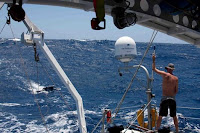Noon position 23°45'54.00"N 147°26'38.40"W
 June 22, 2009
June 22, 2009Last night the late hours of the sampling marathon brought along some chaos. It all started with a lost cod end (the end piece of the net on the Manta trawl, where the debris and plankton are collected) and escalated from there…
To start with, conditions were a little rough. We were operating three different sampling devices (the Manta, the Bongo nets, and the small square net) with a sea state 5/6…..at night. Although the conditions were less than ideal, we all shared the Captain’s sentiments…..”if we’re not willing to do this, then who will?” We are outside of the area that any government entity is obligated to care about. So we pushed away the urge to sleep and plowed on with the sampling.
At 8:20pm, we pulled in the Manta trawl only to find that the whole two hours of sampling was fruitless. The sea freed the cod end of the net, and took our data along with it. No doubt a small disappointment, but we moved right along, put another cod end on and put the trawl back out. We pulled in the next trawl at about 10:30pm. This one produced several small fish, including Myctophids, a couple flying fish, and a saury, which was exactly what we were looking for-fish to analyze for plastic ingestion.
We had a system set up, Christiana and I processed the samples (removed them from the net, labeled them, and fixed them in formalin) while the Captain, Drew, Jeff, and Joel retrieved and deployed the sampling devices. As the Manta was being redeployed from its 10:30 retrieval, Christiana and I heard some commotion among the deployment team and the phrase “…the wing is broken!” At that point there was a mad scramble to bring in the Manta. One of the control lines was rendered useless and the guys had to get creative with boat hooks in order to save the wounded Manta trawl. Once on deck the extent of the damage was visible; one wing snapped and the other one was a bit warped as well. One of the attachment hooks for the line broke off as well, but perhaps most significantly the j-bar holding the satellite was warped from the unbalanced force of the Manta trawl. At this point we were all wondering how things went so wrong, and how we were going to keep sampling. We were right in the thick of the plankton accumulation zone testing in for the hypothesized concentration of debris…it would be a shame to let this opportunity pass.
As it turned out, several factors had compounded in the failure of the Manta trawl. First off, our spotlight decided to die mid-deployment. As the battery was being switched out, the crew was unable to evaluate the deployment of the trawl, which requires a balance of tension between two lines. Hopefully repairs can be made once we arrive in Hawai'i.
Bottom line, everyone was okay. We decided to improvise, using the small square net as a surface trawl, which we found out was torn from its frame during its last run. After some repairs, the net was deployed and for the rest of the late night/early morning sampling the crew was split into shifts: the Captain, Jeff, and myself and Christiana, Joel, and Drew.
The square net does not perform anywhere near as well as the Manta. So this morning brought a new trawling design. We kept the Bongo nets at the surface to imitate the Manta.
Chrisitana and Jeff each reeled in a mahi mahi today, one right after the other. The fish served a double purpose, science and sustenance. Before we filleted the fish, Christiana took muscle and liver samples of each of the fish and looked in their stomachs. Fish number 3, the mahi mahi that Jeff reeled in, contained what the Captain confirmed via microscope as none other than a piece of plastic film. This now makes 8 species of fish in which we have identified with plastic in their gut.
The last set of trawls came in at 5pm. Overall we were able to run 11 Bongo trawls (3 of which imitated the Manta), 6 regular Manta trawls, and 6 trawls with the small square net. It was a productive, though hectic, sampling marathon. Although the samples have yet to be thoroughly analyzed, we were able to spot differing densities of plastic within and outside of the boundaries of the plankton (and possibly debris) accumulation zone. At the end of a long stint of sampling and a significant find of plastic in a common food fish, the Captain prepared one of his specialties chili rellenos accompanied by rice, beans, fresh guacamole, and fresh salsa. It was a perfect end to a productive day. We are now en route to Hawai’I with aboiut 400 miles to go.
Stay tuned for more updates and be sure to check out the
Scientific American website in the
“60 second science blog”, where Drew ‘s weekly account of our voyage is posted.

































